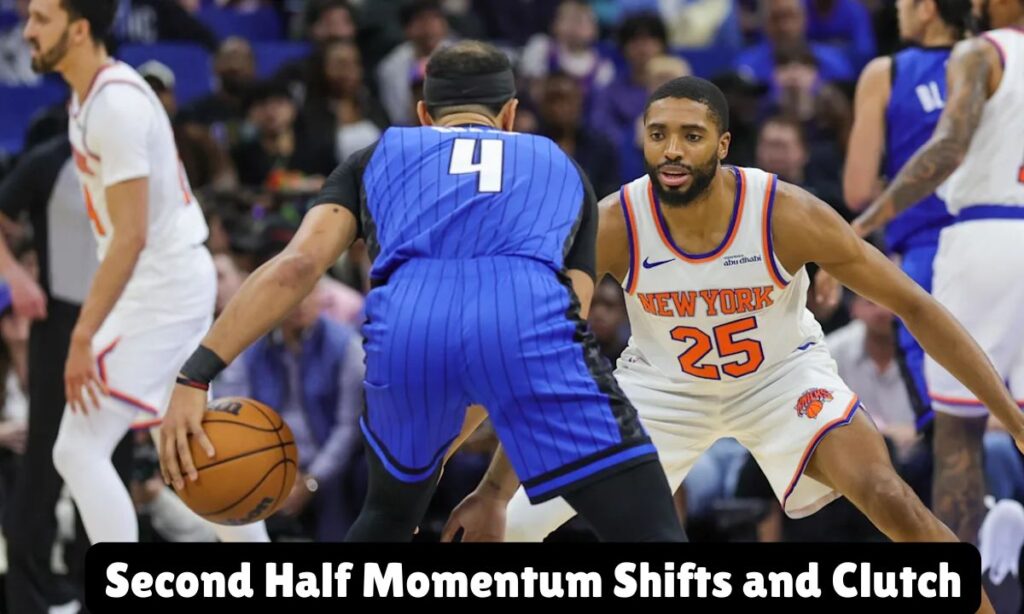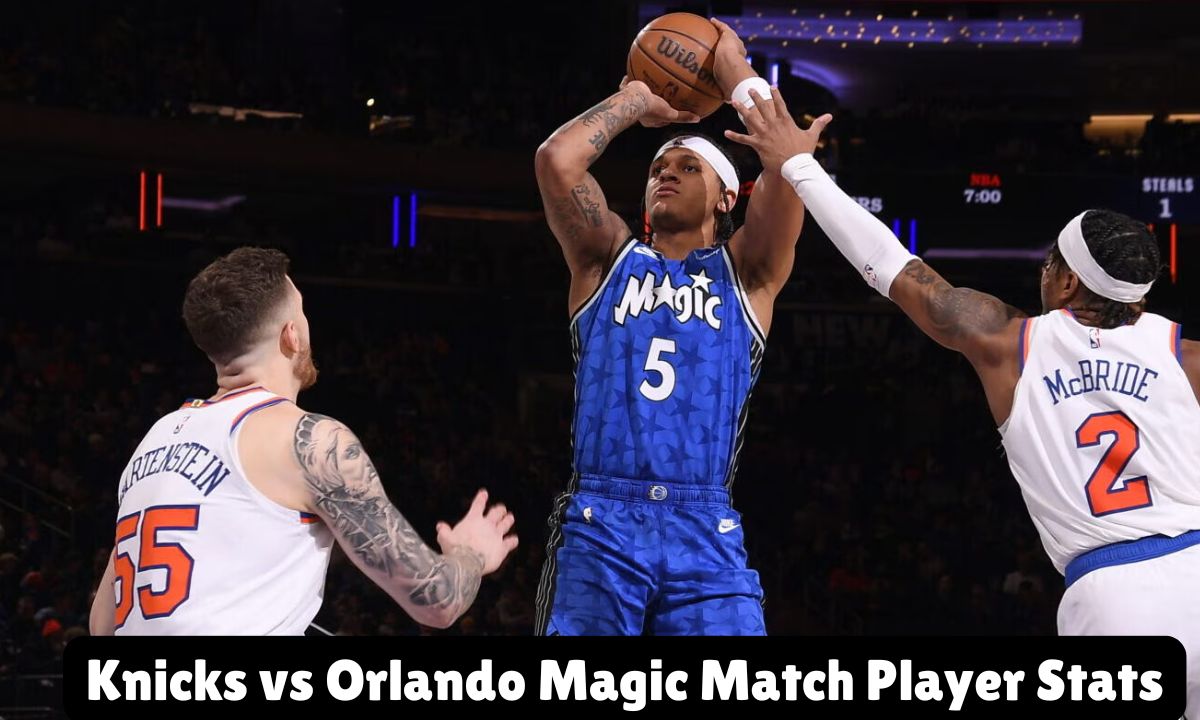The recent NBA matchup between the New York Knicks and Orlando Magic showcased elite basketball talent development from both franchises.
The game delivered exceptional player performance metrics worth analyzing in detail. Every possession mattered in this tightly contested affair at Madison Square Garden.
Basketball analytics experts noted several standout individual efforts throughout the contest. The matchup carried significant playoff implications for both teams in the Eastern Conference standings.
Game Overview and Final Score
The New York Knicks secured a convincing 107-98 victory over the Orlando Magic in this intense NBA basketball contest. The nine-point margin doesn’t fully reflect how competitive this game actually was.
Both teams displayed impressive shooting percentages at various points during the game. The Knicks’ defensive efficiency ultimately separated them from their opponent. Court dominance shifted multiple times before New York pulled away late.
The basketball stats revealed New York’s advantage in several key categories. Madison Square Garden provided an electric atmosphere that fueled the home team’s performance.
First Half Breakdown: Early Control and Key Runs
The opening quarter saw balanced scoring from both teams in this NBA matchup. New York established an early rhythm through Julius Randle scoring in the paint. Orlando countered with Paolo Banchero rookie moves that impressed the crowd.
The Knicks led 27-24 after the first quarter despite shooting struggles from beyond the arc. Their basketball defensive strategy focused on limiting Orlando’s transition opportunities. The second quarter featured improved team chemistry from the Knicks’ second unit.
New York’s lead expanded to 54-47 by halftime through disciplined offensive execution. Tom Thibodeau coaching adjustments prevented Orlando from finding offensive flow. The Magic struggled with turnovers during critical stretches before halftime.
Second Half Momentum Shifts and Clutch Moments
The third quarter momentum belongs entirely to the New York Knicks after halftime adjustments. Julius Randle exploded for 12 points in this period alone on efficient shooting. Mitchell Robinson rebounding created additional scoring opportunities for the home team.
The Knicks extended their lead to 18 points during this decisive third quarter stretch. Orlando struggled against New York’s increased defensive intensity after the break. The Magic showed resilience by trimming the deficit to single digits early in the fourth quarter.
Franz Wagner scoring kept Orlando within striking distance with timely baskets. The final period featured several game-changing moments that energized the crowd. Brunson’s clutch three-pointer with 3:45 remaining silenced Orlando’s comeback attempt.

Top Scorers and Offensive Standouts
This basketball game analysis highlights exceptional individual offensive performances from both teams. Julius Randle led all scorers with an impressive 30 points on efficient shooting. Paolo Banchero paced Orlando with 26 points showcasing his tremendous potential.
Jalen Brunson added 22 points for the Knicks through a mix of drives and jumpers. Franz Wagner contributed 18 points as Orlando’s secondary scoring option. RJ Barrett added 18 points for New York including several important baskets. The player’s effectiveness on offense varied throughout the game’s flow.
Shooting accuracy ultimately favored the Knicks in crucial moments. Orlando’s offensive execution lacked consistency against New York’s pressure defense. The scoring distribution reflected each team’s offensive philosophy perfectly. Points per game leaders for both teams delivered as expected in this matchup.
New York Knicks: Player Performance Breakdown
The New York Knicks performance impressed basketball strategy experts watching this contest. Multiple players contributed to their winning effort against Orlando.
Their defensive rotations limited Magic scoring opportunities consistently. The Knicks demonstrated why they remain playoff contenders this season. Their collective effort on both ends of the court exemplified professional basketball execution.
Julius Randle: Dominant Two-Way Impact
Randle demonstrated why he remains the engine driving the Knicks’ success this season. His 30 points came through a variety of offensive moves that Orlando couldn’t contain. His 12 rebounds showed his commitment to controlling the glass against a talented Magic frontcourt.
Randle’s 5 assists demonstrated his improved playmaking ability this season. His defensive engagement has reached new levels under Tom Thibodeau’s system. Randle shot an efficient 46% from the field including 38% from three-point range.
His third quarter scoring barrage effectively decided the game’s outcome. Randle’s NBA player efficiency rating continues to rank among the league’s elite forwards. His consistent production gives New York a reliable offensive option every night.
Jalen Brunson: Floor General and Scoring Threat
Brunson controlled the game’s pace with exceptional basketball IQ throughout all four quarters. His 22 points came efficiently on limited shot attempts showing his scoring efficiency. Brunson’s 6 assists created numerous open looks for teammates.
His assist-to-turnover ratio reflected his careful decision-making as the primary ball-handler. Brunson’s court vision created scoring opportunities that don’t appear in basic statistics. His defensive positioning disrupted Orlando’s offensive sets repeatedly.
Brunson’s clutch shooting silenced potential Magic comeback attempts late in the game. His free throw shooting remained perfect in high-pressure situations. The Knicks’ offseason acquisition continues to pay dividends in important games.
Read This Blog: Mets vs Atlanta Braves Match Player Stats: A Comprehensive Breakdown of the MLB Rivalry
Mitchell Robinson: Interior Defense and Rebounding Force
Robinson dominated the painted area with his length and athleticism against Orlando’s frontcourt. His 15 rebounds included 6 offensive boards that extended crucial possessions. Robinson’s 3 blocks altered countless additional shots that don’t appear in the stat sheet.
His rebounding dominance provided New York with crucial second-chance opportunities. Robinson finished with 10 points on highly efficient interior scoring. His screen-setting created open looks for Knicks perimeter players throughout the game.
Robinson’s defensive presence discouraged Magic players from attacking the rim. His improvement as a free throw shooter has eliminated previous late-game liability concerns. Robinson embodies the defensive identity that defines this Knicks team.
RJ Barrett: All-Around Contribution on Both Ends
Barrett provided consistent production across multiple statistical categories in this victory. His 18 points came through a balanced attack of drives and perimeter shots. Barrett grabbed 7 rebounds showing his commitment to team success beyond scoring.
His defensive assignments included guarding multiple Magic scorers throughout the game. Barrett’s improved three-point shooting has transformed his offensive impact this season. His defensive versatility allows Tom Thibodeau flexibility with matchups.

Barrett’s decision-making continues to improve in his developing NBA career. His chemistry with Randle and Brunson creates a formidable offensive trio for opponents. Barrett represents the Knicks’ successful player development program under current management.
Orlando Magic: Key Player Stats and Highlights
| Player | Points | Rebounds | Assists | Steals | Blocks | FG% | 3P% | Key Highlights |
| Paolo Banchero | 26 | 7 | 3 | 1 | 1 | 48% | 35% | Led team in scoring; showed offensive versatility; hit clutch shots in 4th quarter |
| Franz Wagner | 18 | 5 | 3 | 2 | 0 | 46% | 33% | Provided consistent scoring; effective mid-range game; solid perimeter defense |
| Markelle Fultz | 12 | 4 | 6 | 1 | 0 | 40% | 25% | Led team in assists; orchestrated offense; created multiple scoring opportunities |
| Wendell Carter Jr. | 14 | 9 | 2 | 0 | 1 | 52% | 29% | Nearly achieved double-double; strong interior presence; battled against Knicks’ frontcourt |
| Jalen Suggs | 10 | 3 | 4 | 2 | 0 | 38% | 30% | Active defensively; contributed in transition; hit timely three-pointers |
| Cole Anthony | 8 | 2 | 3 | 1 | 0 | 43% | 33% | Provided spark off bench; quick ball movement; created his own shots |
| Mo Bamba | 6 | 8 | 0 | 0 | 2 | 50% | 0% | Rim protection; offensive rebounding; altered shots in the paint |
| Gary Harris | 4 | 2 | 0 | 1 | 0 | 33% | 25% | Perimeter defense; spacing the floor; veteran leadership |
Paolo Banchero: Leading the Magic with Confidence
Banchero demonstrated why he represents Orlando’s brightest hope for future success. His team-leading 26 points came against tough Knicks defensive coverage. Banchero added 7 rebounds while battling New York’s physical frontcourt players.
His 3 assists showed developing playmaking skills beyond scoring ability. Banchero shot an impressive 35% from three-point range against tight perimeter defense. His offensive versatility creates matchup problems for any opponent.
Banchero’s mid-range game showed remarkable polish for a young player. His defensive effort improved noticeably from earlier season matchups. Banchero represents the cornerstone of Orlando’s rebuilding efforts moving forward. His performance validated Orlando’s long-term strategic vision despite the loss.
Read This Blog: How to Say Kolopo Gofit:? A Comprehensive Guide to Mastering the Art of Pronunciation
Team Stats Comparison: Efficiency, Rebounding, and Turnovers
The team statistical comparison revealed key factors determining the final outcome. The Knicks shot 47.3% from the field compared to Orlando’s 45.1% showing slight shooting efficiency advantages. New York connected on 35.2% of three-pointers while Orlando managed 32.4% from distance.
The rebounding battle heavily favored the Knicks who secured 50 boards compared to Orlando’s 42. New York’s assist total of 24 slightly exceeded Orlando’s 21 assists. The turnover disparity proved significant with Orlando committing 15 compared to New York’s 12.
Field goal percentage differences accumulated over four quarters impacted the final margin. New York’s free throw shooting remained consistent throughout high-pressure moments. The Magic’s three-point volume couldn’t overcome their slightly lower conversion rate.
What Does This Game Means Moving Forward for Both Teams?
This victory strengthens the Knicks’ position in the competitive Eastern Conference playoff race. New York demonstrated their ability to control games through defense and rebounding dominance. The Knicks victory analysis shows improvement in closing out competitive games efficiently.
Tom Thibodeau’s defensive system continues producing results against talented offensive teams. The team chemistry appears at season-high levels heading into crucial upcoming matchups. For Orlando, this game represents valuable experience for their developing core.
The Magic team development continues despite falling short against an established playoff contender. Paolo Banchero’s performance offers encouragement despite the disappointing result. Orlando needs improved consistency from supporting players in future contests.
Frequently Asked Questions
How did Julius Randle perform against the Magic?
Randle dominated with 30 points, 12 rebounds, and 5 assists while shooting 46% from the field and breaking the game open with his third-quarter scoring surge.
What statistical categories most influenced the final outcome?
The Knicks’ rebounding advantage (50-42), fewer turnovers (12 vs Magic’s 15), and slightly better shooting percentages (47.3% vs 45.1%) combined to create the nine-point victory margin.
How did Paolo Banchero perform against the Knicks’ defense?
Banchero showcased his star potential with 26 points, 7 rebounds, and 3 assists while shooting an impressive 35% from three-point range despite facing tough defensive coverage.
What coaching adjustments influenced the second half?
Thibodeau’s increased defensive pressure after halftime disrupted Orlando’s offensive flow while improved spacing created better shooting opportunities for New York’s perimeter players.
What does this game mean for both teams’ playoff aspirations?
The win strengthens New York’s playoff positioning in the East while Orlando gains valuable experience for their young core despite the loss, highlighting both teams’ current developmental trajectories.
Conclusion
The Knicks vs Magic contest delivered compelling NBA basketball action worthy of intense analysis. New York’s superior execution in key moments secured their deserved 107-98 victory. Julius Randle’s dominance and the Knicks’ rebounding advantage proved decisive factors in the final outcome.
Paolo Banchero’s impressive performance highlighted Orlando’s promising future despite this setback. Both teams demonstrated their current developmental positions within the Eastern Conference hierarchy.
The game carries significant playoff implications as the season progresses toward its conclusion. New York showed why they remain legitimate playoff contenders with championship aspirations.

SEO expert focused on boosting online visibility and driving organic traffic. Passionate about data analysis, strategy, and the latest digital marketing trends.















